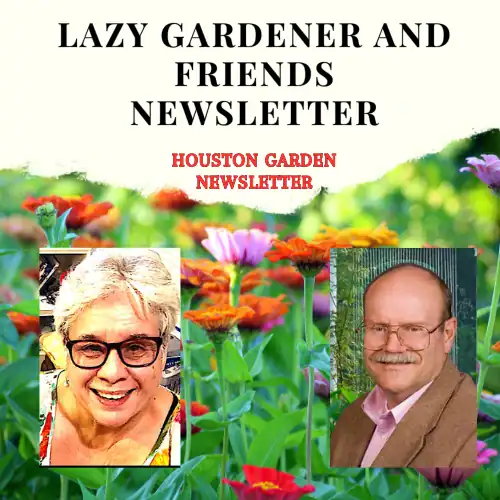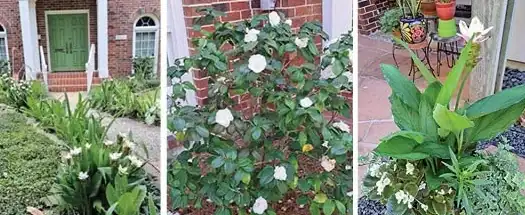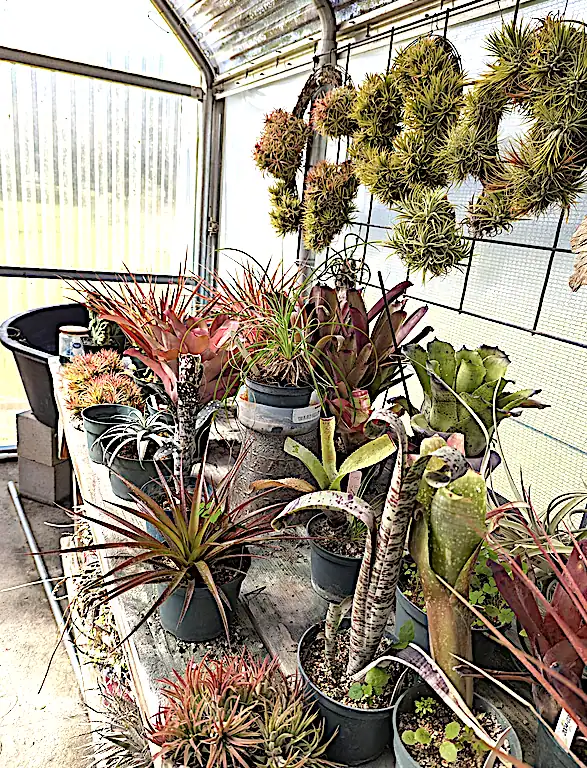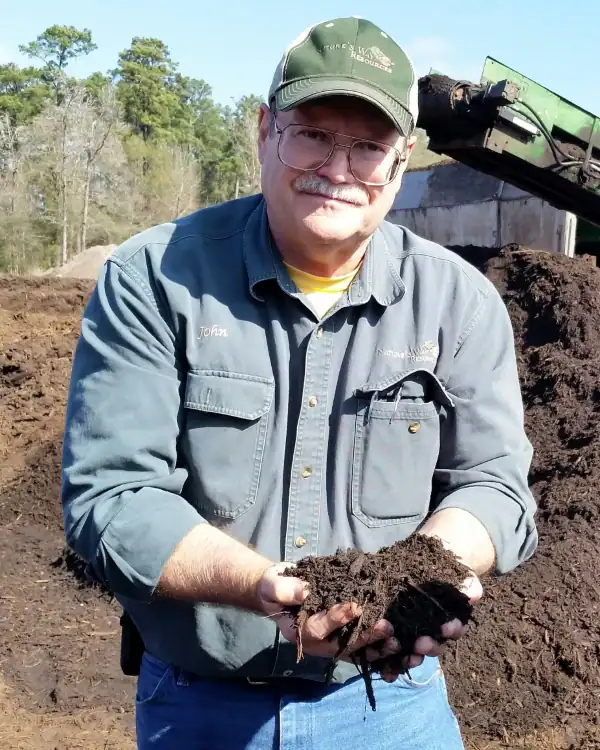
Nature’s Way Resources is proud to bring you this free weekly newsletter. While we don’t run ads, generous sponsors help support this project as a public service. Their names are listed below, please consider showing your appreciation by supporting their businesses!
Nature’s Way Resources honors the contributions of our late owner, John Ferguson. “The Lazy Gardener” Brenda Beust Smith and Shelby Cassano welcome your feedback and remain grateful to the many horticulturists who share their expertise.

by Brenda Beust Smith | The Lazy Gardener
No doubt now, fall weather is here, and we’re in luck. Take this transition time to think more about what pleases you best in your garden. Then figure out ways to not only improve on that enjoyment, but to enhance the overall look as well.
First, reader LYNN SMITH’s love of white flowers has triggered a clever way to utilize different color additions to make the white even more striking. Then LINDA WHIPKEY gets us back into practical mode with tips on helping bromeliads.
Lynn wrote: “BY LYNN SMITH
I am really partial to white flowers, have had all white flowers for many years but lately have gone with colorful blooms in between. This year I planted zinnia seeds and coreopsis seeds and a few came up so a little color now.
My yard is 95% perennials and in spring it is amaryllis–many colors–
and oxblood lily(s). Then, when they are going out, it all turns white again, (making a far more striking impression). L-R: Front walkway perennial beds. Color from March thru October. Beginning with 200 red & white amaryllis, spider lily, oxblood lily, tuberose, naturalized chives, white Siam lily, white ruellia, white rain lily. Center: 1st bushy plant next to brick wall: Nuccio’s Gem Camellia. Beautiful glossy green leaves, naturally rounded shape bush.
Flowers profusely in Dec & Jan. No bugs, struggles in summer heat but always recovers once cooler days arrive. Survived Uri with some extra attention. I do not cover in cold weather, has to survive as-is. Right: Big pots with ivy, white begonia, Siam lily. The Siam lily is a profuse bloomer in summer heat. Loves heat, only blooms once days are at least 85+. Well drained soil, needs water but tolerates dry spells. Hard to kill, you can ignore it if planted in the ground.
* * *

YOUR BROMELIADS NEED YOU — NOW!!!
by LINDA WHIPKEY
BROMELIAD SOCIETY/HOUSTON
Mid-October is time to get ready to protect your bromeliads from coming cold, damp winter we get in Houston.
Consider November as a transition month when the average high temperature at beginning of month is usually in the mid-70s. As time goes on, temperatures fall to high 60s. With lows approaching the 40s, if you haven’t taken precautions, your bromeliads are in danger.
Precautions include:
- Sheltering plants – Most important measure to protect from colder temperatures. Many people bring bromeliads into the house or garage. Due to their primarily tropical nature, almost all bromeliads will need to be brought inside.
- Inside micro-climates differ greatly from what they are accustomed to outside in the summer.
- Check for pests anytime you bring a plant inside from outside, especially on undersides and at axils where leaves meet the stem.
- Keep brought-indoor plants separate from usual house plants for a few weeks. Remove pests such as scale or mealy bugs by swabbing them with rubbing alcohol. Rinse the plant with water and allow it to dry.
- Clean pots. Wash each pot with soap and water, rinse with a diluted bleach solution, let dry completely, and then rinse again with water.
- Cut back watering. In the house, the warmth can stress the plant. Furnaces and heaters rob the air of water vapor. This doesn’t mean that you water more often. It means plants will go through a period of very slow or absent growth. Thus, watering can be cut back. When you do water, soak the container thoroughly and allow excess water to run out. You do not want potting soil to remain soggy, or the plant could suffer from root rot. Broms can act like succulents, and some are.
- Increase humidity. Use a humidifier or group plants together in pebble trays to create the surroundings with higher humidity.
- Light. In the house, chances are they still are getting some light. In the garage, plants have to adapt to the amount of light they get. Ensure they receive bright, indirect light, adjusting the plant’s location as the angle of the sun changes. Open the garage door on warm days to get light in.
If you can’t bring in plants — too big or inground — cover with frost cloth or blankets during cold nights – in the 30s and low 40s. Unfortunately, we as plant growers cannot do anything about the weather.
* * *

Sometimes mushrooms are hard for even experts to identify. Cory thinks these might be green-spored parasol mushrooms. Houston Botanic Garden photo
Don’t miss FUNGI FEST!
by CORY SAUL & JASON LACEY
HOUSTON BOTANIC GARDEN
Mushrooms, like plants, are extremely diverse in our region. Some are more common than others, like Green-spored Parasol (Chlorophyllum molybdites), but from the gardener’s perspective, it’s often enough to simply learn why mushrooms show up, and what they indicate. It turns out, they have a lot to tell us.
Mushrooms are always a sign of decay, but, at least when they are emerging from the ground, they are rarely a sign of parasitism or poor garden health. They aren’t the bad guys! In fact, mushrooms (or the fungi they are a part of) are doing their part to recycle organic material.
When we see ground mushrooms at Houston Botanic Garden, we typically glean two things right off the bat: Organic matter is high. The substrate is wet and staying wet
For example, if Flowerpot Parasol (Leucocoprinus birnbaumii) is showing up in our Cactus Garden, the nutrient level might be too high for arid plants, and the soil might not be draining as well as it should.
At the Garden, we typically let mushrooms lie. They are fun-looking, show off Houston’s biodiversity, and they do not stick around for long. If anything, instead of addressing the mushrooms, we’ll adjust the space in which they appear, so it drains better and participates more effectively in the nutrient cycle.
For those concerned about mushroom toxicity, the immediate solution is always to remove the mushrooms as they appear. It’s important to remember that many fungicides are non-selective, so when you’re killing the bad, you’re also killing the good.
Don’t miss FUNGI FEST (https://hbg.org/event/fungi-fest/ )
* * *

ATTN. GARDEN/PLANT GROUPS
— Nature’s Way Resources offers free guided tours of NWR’s extensive nursery/soil/mulch facilities for garden clubs, plant societies and other plant-oriented, organized groups. As usual, NWR’s now-expanded meeting site is free to above groups. Reservations a must for both. Great time to visit.
Want to receive The Lazy Gardener & Friends weekly newsletter?
John’s Corner
NEWS FROM THE WONDERFUL WORLD OF SOIL AND PLANTS
Subject: Soil Science for Regenerative Agriculture and The Regenerative Agricultural Solution
Please enjoy this column from October 2024.
Click below to learn more about all of the different types of mulch in detail.
Explore our article library to learn more information about various mulches and other topics.
Calender Submittal Rules
WANT EVENT IN RIGHT AWAY? FOLLOW RULES!— ONLY GREATER HOUSTON AREA NONPROFIT GROUP EVENTS —
Expect delay if we must reformat: 3-LINE (max) EXACT FORMAT:
DAY, DATE: TITLE (by NAME if talk), time, site. Sponsor (if not in title). website/phone (NOTE CAPITALS VS lower case)
- Gardening events ONLY! No harvest, cooking, arranging, etc.
- ONLY events sent SPECIFICALLY TO US FOR CALENDAR are used!
- NO events picked up from flyers — NO PDFS! TYPE IN EMAIL ONLY.
- Don’t add city unless not “Houston.” (Don’t add “Houston”)
- Submit to: lazygardenerbrenda@gmail.com. Check published entry!
Sponsorship
If you are interested in becoming a sponsor, please contact us at 936-273-1200 or send an e-mail to: lazygardenerandfriends@gmail.com
About Us
BRENDA BEUST SMITH
WE KNOW HER BEST AS THE LAZY GARDENER . . .
but Brenda Beust Smith is also:
- a national award-winning writer & editor
- a nationally-published writer & photographer
- a national horticultural speaker
- a former Houston Chronicle reporter
When the Chronicle discontinued Brenda’s 45-year-old Lazy Gardener” print column — started in the early ’70s as a fun side-project to reporting, it then ranked as the longestrunning, continuously-published local newspaper column in the Greater Houston area. The name, she says, is not just fun, it’s true.
Brenda’s gradual sideways step from reporter into gardening writing led first to an 18-year series of when-to-do-what Lazy Gardener Calendars, then to her Lazy Gardener’s Guide book which morphed into her Lazy Gardener’s Guide on CD, which she now emails free upon request.
Brenda became a Harris County Master Gardener and, over the years, served on theboards of many Greater Houston area horticulture organizations. She hosted local radio and TV shows, most notably a 10+-year Lazy Gardener specialty shows on HoustonPBS (Ch. 8) and her call-in “EcoGardening” show on KPFT-FM.
For over three decades, Brenda served as Assistant Production Manager of the GARDEN CLUB OF AMERICA’S “BULLETIN” magazine. Although still an active broad-based freelance writer, Brenda’s main focus now is THE LAZY GARDENER & FRIENDS HOUSTON GARDEN NEWSLETTER with John Ferguson and Pablo Hernandez of Nature’s Way Resources.
A native of New Orleans and graduate of St. Agnes Academy and the University of Houston, Brenda lives in Humble, TX, and is married to the retired Aldine High School Coach Bill Smith. They have one son, Blake.
Regarding this newsletter, Brenda is the lead writer, originator of it and the daily inspiration for it. We so appreciate the way she has made gardening such a fun way to celebrate life together for such a long time.
About her column, Brenda says: “I don’t consider myself a ‘garden writer.” I started out 50+ years ago as a very lazy “gardening reporter.” I still feel that way today. I hope my columns inspire/help newcomers, but I do not write to them. I write to very experienced gardeners who want to expand their horizons.
JOHN FERGUSON
John is a native Houstonian and has over 35 years of business experience. He owns Nature’s Way Resources, a composting company that specializes in high quality compost, mulch, and soil mixes. He holds a MS degree in Physics and Geology and is a licensed Soil Scientist in Texas.
John has won many awards in horticulture and environmental issues. For years he represented the composting industry on the Houston-Galveston Area Council for solid waste. His personal garden has been featured in several horticultural books and “Better Homes and Gardens” magazine. His business has been recognized in the Wall Street Journal for the quality and value of their products. He is a member of the Physics Honor Society and many other professional societies. John is the co-author of the book Organic Management for the Professional.
For this newsletter, John contributes articles regularly and is responsible for publishing it.
SHELBY CASSANO is the communications and marketing lead for Nature’s Way Resources and the editor of The Lazy Gardener and Friends newsletter. Through her business, Leaf and Ledger, she exclusively partners with NWR to direct all marketing efforts, from campaign strategy and content planning to technical production of the newsletter. Shelby holds a B.S. in Agriculture with a concentration in Horticulture from Stephen F. Austin State University and previously managed the company’s nursery.
Download the Newsletter with Our Events Calendar Below!

NATURE’S WAY RESOURCES
101 Sherbrook Cir.
Conroe, TX 77385
Hours of Operation
Monday – Friday: 8AM to 5PM
Saturday: 8AM to 2PM
Copyright © 2024 Nature’s Way Resources | All rights reserved.



